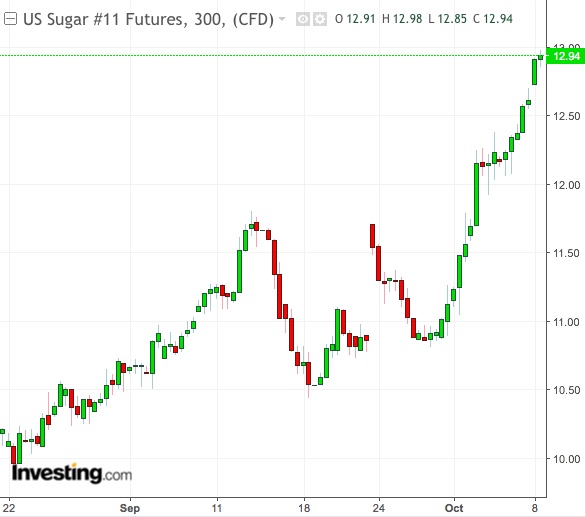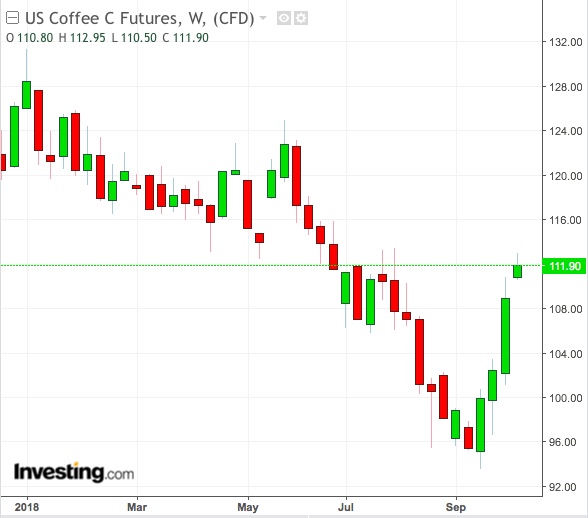To many Brazilians, Jair Bolsonaro, the right-wing presidential candidate who snapped up a 46 percent consensus in the first round of voting on Sunday, represents their best hope to emerge from recession and corruption. Commodity traders think he’s a sweet bet too and are showing it by driving sugar, one of the South American country’s top exports, to a mega rally.

Since August 26, New York-traded raw sugar futures, which provide benchmark pricing for Brazilian sugar, have gained an eye-popping 28 percent—or an average of 3.5 percent a day over eight straight days.
Arabica coffee, another major Brazilian export, has added 15 percent during the same time in New York trade.
Brazilian Real's Rally
The run-up in the two commodities came as Brazil’s real gained 7 percent versus the dollar—not a surprising correlation given that Brazilian farmers sell their harvest in local currency before it hits the international market.
Currency appreciation aside, there’s another reason why sugar and arabica took off with the real from August 26: that was when the first debate of the 2018 Brazilian presidential elections was held, bolstering Bolsonaro’s position as a front-runner versus eight others.
Since then, the ex-army captain, dubbed “Tropical Trump” for his tough stance, reminiscent of the US president, has clinched a resounding preliminary victory in the polls that gives him a clear advantage for the final runoff of October 28, and has even survived a near-fatal stabbing. His dramatic campaign has lit a flame under Brazilian markets, with raw sugar nearly halving its previous annual loss of 32 percent to 15 percent after this week’s rally.
“It’s all Bolsonaro and the real,” said Shawn Hackett of Hackett Financial Advisors, a research firm for agricultural commodities in Boca Raton, Florida. Hackett added:
“Large speculators had been playing for a weak real for months and his resurgence caught them out. There’s massive short-covering going on now, including in sugar and arabica.”
Overbought Markets?
What that also means is the two commodities were technically overbought, posing the risk of collapse should Bolsonaro’s star fade or traders decide to take profit.
On Tuesday, Investing.com’s daily technical outlook for raw sugar was still suggesting a “Strong Buy”, with the strongest resistance—Level 3 Woodie’s—emerging at 13.20 cents a lb.
The most-active raw sugar contract in New York, for March delivery, settled on Monday at 12.94 cents after rising without pause for eight sessions. While it is still early days in October, the 28-percent gain of the past week, if retained, will be the highest for a month in eight years.
Even so, Mike Seery of Seery Futures in Plainfield, Illinois, says those sitting on profitable positions in sugar should be wary of a shift at any time.
Sugar Doesn’t Look Like A 'Straight Rise'
“If you are long multiple contracts, my advice is to take some profit as I have a hard time believing this market will continue to go straight up,” said Seery, a technical chartist who’s been following sugar's gyrations over the year so far, as it went from 10-year lows of 9.91 cents in August to seven-month highs of 12.98 on Tuesday.
With March futures trading above the 20- and 100-day moving averages, Seery sees major resistance at the 13-cent level. He added:
“If you take a look at the overbought indicators, such as stochastics or the RSI oscillator, they are both at extreme levels – which tell you that we are due for some type of pullback, in my opinion.”
Arabica’s Technicals Are Better
As for arabica, the technical position was better than sugar’s, although caution was required too, said Seery. Investing.com’s daily technical outlook for raw sugar was still suggesting a “Strong Buy,” with the strongest sell signal emerging at the 200-day moving average of $1.1408 per lb.
The most-active arabica contract in New York, for December delivery, settled on Monday at $1.1185 cents. It remains down 11 percent on the year despite a gain of more than 13 percent since the end of August.

“It certainly looks to me that coffee prices have finally bottomed,” Seery said, referring to the 12-year low of 93.50 cents struck by arabica in September. “The trend has turned to the upside,” he added.
